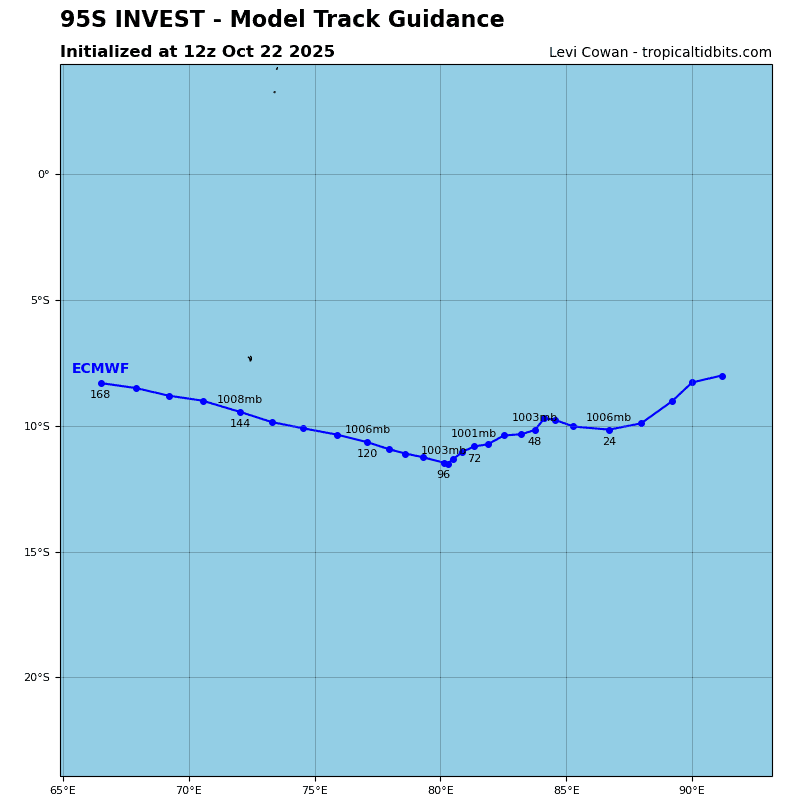Current Snapshot
For all the latest updates visit: DisasterAWARE
By PDC’s Senior Weather
Specialist Glenn James

The Pacific Disaster Center’s (PDC Global) Sunday, February 18, 2024, Tropical Cyclone Activity Report…for the Pacific Ocean, the Indian Ocean, and adjacent Seas
Current Tropical Cyclones:
Tropical Cyclone 13S (Djoungou)…is located approximately 1000 NM south-southeast of Diego Garcia
Northeast Pacific Ocean:
The North Pacific hurricane season officially ended on November 30, 2023. Routine issuance of the Tropical Weather Outlook will resume on May 15, 2024. During the off-season, Special Tropical Weather Outlooks will be issued as conditions warrant.
The eastern Pacific basin hurricane season was above normal, with 17 named storms, of which 10 were hurricanes and eight of those major hurricanes.
From August 16 to 21, Tropical Storm Hilary brought widespread heavy rainfall and flooding to Southern California, with some areas receiving up to 600% of their normal August rainfall. Hilary resulted in the first ever issuance of Tropical Storm Watches and Warnings for the Southern California coastline by NOAA’s National Hurricane Center. In addition, the Center distributed key hazard focused messages for Hilary in Spanish through the agency’s new language translation project.
Hurricane Otis made landfall near Acapulco, Mexico, on October 25 as a category-5 hurricane, with sustained winds of 165 mph. Otis holds the record as the strongest land falling hurricane in the eastern Pacific, after undergoing rapid intensification in which wind speeds increased by 115 mph in 24 hours.
Central North Pacific:
The central North Pacific hurricane season officially ended on November 30, 2023. Routine issuance of the Tropical Weather Outlook will resume on June 1, 2024. During the off-season, Special Tropical Weather Outlooks will be issued as conditions warrant.
The central Pacific basin had a near-normal season with four tropical systems traversing the basin.
Hurricane Dora, a category-4 storm, passed south of Hawaii in early August, marking the first major hurricane in the central Pacific basin since 2020. The strong gradient between a high pressure system to the north and Dora to the south was a contributing factor to the wind-driven, fast-moving wildfires in Hawaii.
Western Pacific, Indian Ocean and adjacent Seas
South Indian Ocean…
Tropical Cyclone 13S (Djoungou)
According to the JTWC warning number 7, sustained winds are 120 knots…with gusts to near 145 knots
Animated multi-spectral satellite imagery depicts tropical cyclone 13S (Djoungou) exhibiting a tightening symmetric eye of 20 NM diameter and smooth cirrus canopy aloft (168 NM diameter). Robust spiral banding persists throughout the eastern periphery of the system with intermittent overshooting cloud tops throughout. A satellite microwave image captured a slight offset of the low level circulation center (llcc) and upper level eye feature, showing the eye feature to be 30 NM east of the llcc and suggesting an eastward tilting vortex with height.
The environment is assessed as highly favorable having significant divergence aloft, warm sea surface temperatures offset by moderate (15-20 knot) vertical wind shear.
TC 13S is forecast to track along the southwestern periphery of the near equatorial ridge to the northeast of the system throughout the forecast period, steering the system southeastward through 48 hours and then gradually turning to an eastward track by 72 hours.
In general, the favorable environment begins to gradually become unfavorable, starting with a rise in vertical wind shear (25-30 knots by 12 hours). Sea surface temperatures are anticipated to steadily drop. Upper level divergence is forecast to sharply cut off between 36 and 48 hours, attributed to significant dry air entrainment starting near 24 hours.
As a consequence, a rapid weakening trend is forecast from 12 to 72 houirs. The system is forecast to begin subtropical transition near 48 hours and be subtropical by 72 hours.
South Indian Ocean…
>>> There’s an area of disturbed weather being referred to as the Invest 95S…which is located approximately 387 NM west-northwest of Mauritius.
Invest 95S will not stop until it gets enough, showing great structural improvement as it has rapidly consolidated over the past six hours. Animated enhanced infrared satellite imagery and a microwave image depict a low level circulation (llc) with deep flaring convection concentrated over and northeast of the perceived low level circulation center and fragmented banding mainly on the southern periphery of the system.
The environment is highly favorable for further development with low (5-10 knot) vertical wind shear, good poleward outflow aloft, and warm sea surface temperatures.
Environmental analysis reveals unfavorable conditions for tropical transition defined by a deep layer of dry air being advected over the circulation, strong westerlies aloft, high (30 knot) vertical wind shear, and cool sea surface temperatures.
Global deterministic and ensemble models are in tight agreement on the development of invest 95S and tracking it northeastward over the next 24-36 hours, but have differences when it comes to speed of the system as it flattens out on an eastward trajectory.
Intensity guidance shows good consensus on invest 95S tracking over a patch of very warm water within the next 12-24 hours, which will fuel rapid and steady intensification before making a southward turn towards the Mascarene islands.
Maximum sustained surface winds are estimated at 23 to 28 knots.
The potential for the development of a significant tropical cyclone within the next 24 hours is high.








